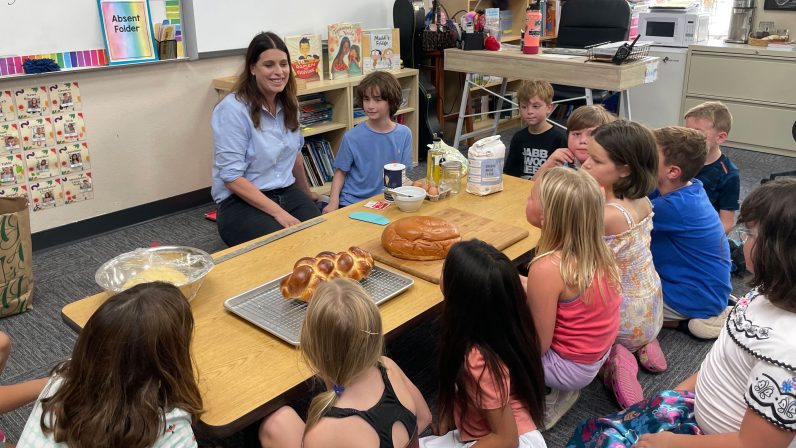Our food study has been deliciously successful this year. In speaking with various teachers, several themes have been present across grade levels:
- learning about foods by color and what they do for our bodies
- inviting parents/grandparents to come in and share favorite or traditional foods of their families/culture
- making a connection to gardening and our upcoming planting season
Several classes focused on food colors and their unique benefits to our bodies. In one class, children sat at a small table making color books of foods. They were gluing pictures of blue and purple foods to a “blue and purple foods give you a strong brain” page. Another class made a beautiful rainbow by making collaged representations of different fruits and vegetables. Each part of the rainbow included the children’s art, a photo of the child, and a quote about their food. Here are a few of their quotes:
- “My green kiwi helps so I won’t be sick and go to the hospital.”
- “My green lime helps “no mas enferma.’ ”
- “My yellow banana helps my skin stay over my bones.”
- “My orange helps so I can see all the animals all the way to the zoo.”
- “My purple grapes help me learn how to get the strawberries from up high when somebody needs it.”
As one class talked about eating a rainbow, they looked at their lunches. The teacher reported that after including a description of this experience with parents, the lunch rainbows became even more colorful the next day.
Another theme for this year was sharing favorite and traditional family foods. One of the toddler classes asked each family to bring in their child’s favorite foods for a snack on a rotating schedule. Some of the foods brought in were oranges and freeze dried strawberries, pickles, pesto pasta, and yogurt parfaits. Parents and grandparents came in to various classes to lead a cooking/food project. One mom made some delicious guacamole that included pomegranates. Another class, that has cooked their way through all the food groups, will be inviting parents to come in on Friday for a group lunch of pasta and freshly made pesto using basil from their class garden and gardens from some of the school families.
One of the older groups had quite a bit of family participation. A grandmother came in and demonstrated how to make empanadas, filling the school with the scent of fresh baked pastries. A different parent made kale chips with the class and shared cucumbers from their home garden. One parent made smoothies with the students and today a mom came in to show the class how to make challah. Still on the scheduled is making spring rolls and beet juice. Their emphasis has been family and cultural foods.
A final theme has been examining different foods, in particular their seeds, and creating a link to the upcoming planting season. One of younger classes used the book Summer Soup as a guide, talking about things nature provides to make food for healthy bodies. They did an art project creating their own “soil,” using brown tempera paint, glue, and sand. They used real seeds extracted from taste tests of veggies, including bell peppers, tomatoes, cucumbers to “plant” in their “soil.” Their intention is to plant the left over seeds in their real garden in the coming weeks. They also used dried veggies to make prints and other materials to make stems for their soil mural.
This is but a fraction of the excellent work happening during our food study. We do it each year to raise awareness about food and nutrition, prepare the way for planting our gardens, and begin to engage families in the school through food experiences. In essence it’s a time to plant seeds, both literally and symbolically. We’re building awareness that will benefit individuals, as it also strengthens our Seed community and choices that will affect life on Planet Earth.

